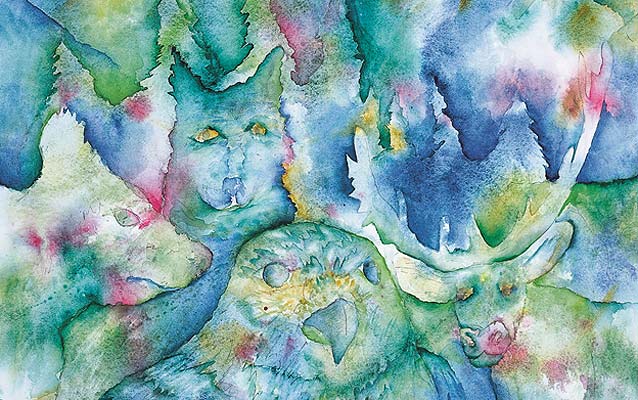Lesson Plan

- Grade Level:
- Fourth Grade-Eighth Grade
- Subject:
- Biology: Animals
- Duration:
- 1 hour
- Group Size:
- Up to 36 (6-12 breakout groups)
- Setting:
- classroom
- National/State Standards:
- WY Grade 4 Science 1.5, 1.6, 1.9, 2.2, 2.6, 5.4
WY Grade 4 Art 1.3
WY Grade 8 Science 1.4, 1.5, 1.6, 2.2, 2.6, 5.2\
WY Grade 8 Art 1.3
Next Generation Science Standards: 3-LS4-2., 3-LS4-3., 3-LS3-2. - Keywords:
- habitat, adaptations, ecosystem, biology
Overview
Students work collaboratively to create fictitious animals in order to understand adaptations that help wildlife survive among various habitats throughout the Greater Yellowstone Ecosystem.Objective(s)
- Identify specific adaptations that aid animals in survival.
- Define adaptation, ecosystem, community, habitat, ecological niche, species, generalist, and specialist.
- Understand the special environment of the Greater Yellowstone Ecosystem and its diverse habitats.
Background
The Greater Yellowstone Ecosystem is one of the last diverse, relatively intact, ecosystems in the world! All organisms that live in varied habitats have physical, biological, and behavioral adaptations that help them to survive in their environment. Found within the Greater Yellowstone Ecosystem are habitats as different as hydrothermal pools and alpine meadows above tree line.Materials
Habitat cards (five total), sketch paper (several pieces for each group, large enough for the class to see the invented animal during presentations), notebooks, colored pencils.Procedure
The teacher will:
- Review the following terms and write definitions on the board. Have students copy them.
Ecosystem: large ecological unit or area where plants and animals live and interact with biotic factors of the physical environment.
Abiotic Factor: a characteristic of the physical environment such as temperature, humidity, slope, soil type, shade, and wind.
Community: the living components of an ecosystem. The plants and animals forming the community are dependent upon one another. Several different types of communities may be found in the same ecosystem. The community of life makes up the biotic factors of the environment.
Habitat: An organism's home, the place where it finds what it needs to survive. A good habitat provides food, water, shelter, and space.
Niche: The role a particular organism plays within its community. If we think of habitat as an animal's or plant's address, the niche would be its job.
Species: Organisms with shared characteristics, capable of interbreeding.
- Explain how physical, biological, and behavioral adaptations help Yellowstone's animals survive. Ask the students to list examples of physical, biological, and behavioral adaptations found among plants and animals in the Yellowstone ecosystem. Write them on the board. Draw an example of a fictitious creature such as a "jackalope" or an "aquamoose" containing multiple adaptations. Explain the importance of each adaptation and how it aids the animal in daily life.
- Explain that their small groups will soon transform into "bio-engineers," and it will be up to them to design or create a new animal for the Greater Yellowstone Ecosystem.
- Tell the students that this is a team activity. Every student needs to participate to make it a success. One student in each group should be the designated sketch artist. Another should be the "scribe" in charge of keeping a list of the special adaptations this new creature will have to help it survive in its Yellowstone habitat. Distribute field guides as reference material. Each group should have a few blank pieces of paper to sketch on as well as colored pencils to make their creatures come "alive."
- Give each group a habitat card and explain that the animal they invent must have adaptations that enable it to thrive in the habitat it has been assigned.
- Write some questions on the board that each group should answer, as the students start to design their creature, such as:″
Does your creature lay eggs? If so, how many eggs?
Does your creature give live birth, like a bison? If so, how many young are born each year?
Is your creature camouflaged? What in its habitat does it blend into to hide?
Is your animal a carnivore, omnivore, or herbivore? What does it eat?
Does it have any enemies?
How does it protect itself?
Does your creature hibernate? Does it migrate?
Where would your animal live in its habitat—a den, a nest, or an open field?
- Allow 15-20 minutes for the students to design their creature. After they have finished their drawings and answered all or most of the questions, allow the whole group, one at a time, to present their creature to the rest of the class.
Assessment
During the introduction to new vocabulary and concepts, the teacher may check for understanding through questioning and monitoring of student progress in recording definitions. While the small groups are “inventing” their animals, the teacher can circulate through the groups monitoring for participation from all group members as well as prompting each group to explain how their chosen adaptations help their animal survive in its given habitat. Guide groups as necessary toward fitting adaptations to habitats. During each group’s presentation of their animal, the teacher should ask questions of the group to assess the synthesis of adaptations, survival, and habitat.Park Connections
This lesson utilizes habitat types found in the Greater Yellowstone Ecosystem (such as hydrothermal areas) and many of the adaptations the groups come up with will likely be found in various Yellowstone species. Many of the habitats used can be found in a wide variety of ecosystems throughout the world.Extensions
The teacher may decide to assign several adaptations to each group to force them to use adaptations that have been previously examined in class rather than letting groups come up with adaptations on their own. Any habitats can be used for this activity.Additional Resources
The annually published Yellowstone Resources and Issues Handbook provides a wide variety of additional information on Yellowstone’s natural as well as cultural resources. It can be found at https://www.nps.gov/yell/planyourvisit/resourceandissues.htmVocabulary
habitat, adaptation, ecosystem, abiotic factor, community, niche, speciesLast updated: December 20, 2023
